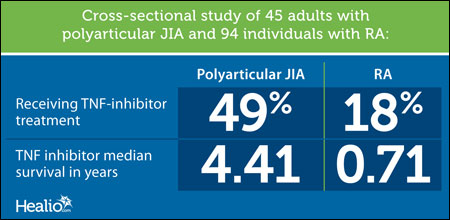Adults With Juvenile Idiopathic Arthritis Distinct From Those With RA
Despite often being grouped together in practice, adults with polyarticular juvenile idiopathic arthritis and those with rheumatoid arthritis are distinct, with markedly different medication needs, according to findings published in the Journal of Clinical Rheumatology.
“In the United States, when pediatric [juvenile idiopathic arthritis (JIA)] patients reach 18 to 21 years of age, their care is transitioned from pediatric to adult rheumatology providers,” Danielle M. Feger, MS, of the Penn State College of Medicine, and colleagues wrote. “After transitioning, JIA patients are likely to be labeled with a diagnosis of rheumatoid arthritis (RA) rather than JIA; one report indicated that 45% of JIA patients received an RA diagnosis from adult rheumatology. ... This diagnosis change makes performance of outcome studies utilizing diagnosis codes to identify subjects difficult and may explain why long-term JIA outcome studies are not frequently reported.”
To characterize the clinical features and therapies involved in cases of adult polyarticular JIA, compared with patients with RA, the researchers conducted a cross-sectional study of 45 adults with the polyarticular JIA and 94 individuals with RA, all recruited through the Penn State Hershey Medical Center system, from 2013 to 2017. All patients were older than 18 years at recruitment.
Classification criteria were compared using χ2 and McNemar tests. The researchers identified polyarticular disease course as arthritis affecting five or more joints after the first 6 months of the disease, with polyarticular JIA information gained through chart reviews. Therapies and medications were evaluated focusing on TNF-inhibitor survival. In addition, the researchers created an accelerated failure-time model for time-to-methotrexate initiation.
According to the researchers, patients with polyarticular JIA were less likely than those with RA to be rheumatoid factor or cyclic citrullinated peptide antibody positive, with fewer than half meeting the 2010 American College of Rheumatology/EULAR classification criteria for RA. In addition, time from diagnosis to methotrexate therapy was associated with longer disease duration in both groups of patients (P < .01). Among patients with polyarticular JIA, 49% were receiving TNF-inhibitor treatment, compared with 18% of those with RA (P < .01). Treatment with TNF inhibitors, and particularly etanercept (Enbrel, Amgen), was sustained longer among patients with polyarticular JIA, with a median survival of 4.41 years, compared with 0.71 years in those with RA (P < .01).

“Adult rheumatologists face challenges caring for and managing [polyarticular] JIA patients,” Feger and colleagues wrote. “Regardless of whether [polyarticular] JIA patients progress smoothly through a well-designed transition from pediatric to adult rheumatology, or present after years of lack of care from loss of health insurance, the ideal management of these patients with established disease and multiple comorbidities has not been studied in randomized controlled trials. This gap in clinical knowledge is highlighted by data showing that adult rheumatologists assign a diagnosis of RA to 45% of JIA patients immediately after transition from pediatric care.” – by Jason Laday
Disclosure: Feger reports no relevant financial disclosures. Please see the study for all other authors’ relevant financial disclosures.
